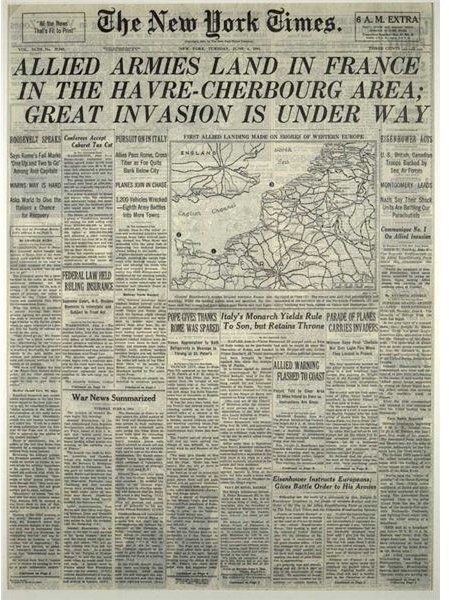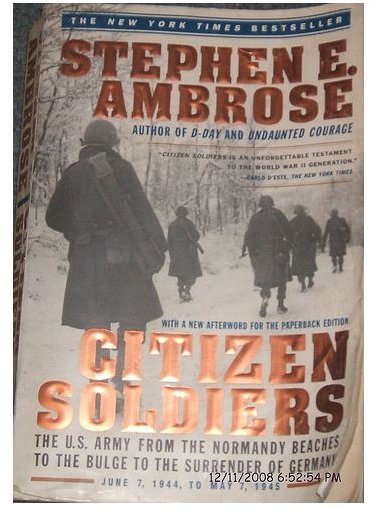World War II Study Guide for Citizen Soldiers
Citizen Soldiers tells the story of the battles leading up to Germany’s surrender through first hand accounts of the men who fought them. It begins on June 7, 1944 (D-Day plus 1), and in many ways is a sequel to Ambrose’s book, D-Day. Citizen Soldiers pays homage to the soldiers, junior officers and NCOs who landed on D-day or followed as replacements. The direct quotes and real-life experiences allow students to learn about the war through varied, personal perspectives. While not bogged down in strategic detail, it provides the overall mission of the Allies and how it was accomplished by the men and women on land, at sea and in the air.
The study guide below covers the Prologue, as well as Chapters 1 and 2 in the 1998 paperback edition of Citizen Soldiers published by Simon & Schuster. The chapter summary questions for Citizen Soldiers can be used alone to develop better understanding while reading the book, as a World War II study guide, or in conjunction with the World War II lesson plan, Who Stands behind a Dud? which may be found in Bright Hub’s K-12 Channel.
Something(s) to Think About While Reading
As a World War II study guide, this article provides several ideas to think about while reading Ambrose’s novel.
Prologue & Chapter 1, Expanding the Beachhead (June 7-30, 1944)
- The hedgerows of France were a formidable challenge to the troops on foot and in tanks. Centuries old, the hedgerows are overgrown with “beeches, oaks, and chestnut trees growing upon the summit.” (Prologue, pg. 19) Often, the branches met over sunken roads creating a dim and disorienting environment. It was a huge intelligence blunder that the Americans, English, and Canadians were not prepared for this obstacle prior to D-Day. Intelligence officers viewing surveillance photo likened them to low hedges found in England and did not foresee the logistical, strategic, and mobility issues they would create. Given this consider the following:
- Notice the encouragement of individual initiative when it came to decision making during combat (i.e.-innovations in tank to infantry communication, tankers using weapons in the hedgerows.) Was the attitude toward privates and NCO’s showing initiative the same in the German and American armies? ( Chapter 1, pp. 34-37)
- What was the difference in training, if any, when it came to the hedgerows? (See Prologue, pp. 17-20)
- Did native German soldiers behave differently in the field than “slave troops”? (see Chapter 1, pp.32-33)
- The Allies sent in massive amounts of replacement troops beginning the morning after D-Day and continued to for the remainder the war. This movement was planned and necessary given the large number of casualties on D-Day and throughout the campaign in Europe. Knowing these facts (heavy losses and the constant flow of planned replacement troops), to which do you think the paratrooper was referring when he said. “Now if you guys are around this time tomorrow you can consider yourself veterans.” (Chapter 1, pg. 37)
- Did the German reinforcement effort differ from the Allies’ effort?
- Which side had more success at limiting the number of reinforcement troops brought in by the other side? How so?
- The sinking of the USS Susan B. Anthony transport ship was considered a success for the Germans. At the same time it proved the effectiveness of the Allies combined naval effort and their specialized vessels. What tactic gave the German’s their success? In what way was it still a victory for the allies? (Chapter 1, pp. 37-38)
- Ambrose describes Normandy as a “soldier’s battle” in that the important choices were made by the platoon, company and battalion in the field. In your opinion, does the experience of the 747th Tank Battalion support Ambrose’s description? (Chapter 1, pp. 51-52)
Front Page - June 6, 1944

Chapter 2, Hedgerow Fighting (July 1-24, 1944)
- Since Hitler’s vengeance weapons (the V-1s) were not considered valuable military tools, why was destroying their launch sites a priority? (Chapter 2, pp. 56-57)
- Why were the V-1s viewed as weapons of terror?
- In your opinion, how does inflicting terror strengthen the perpetrators of the fear, if at all?
- How did the incident experienced by Pvt. Richardson of the 82nd Airborne influence the men involved in terms of future combat decisions? ( Chapter 2, pp. 60-61)
- Do you think the initiative shown by Maj. Gen. Quesada when it came to the use of VHF radios reinforces the idea of Normandy being a “soldier’s battle”? Why or why not? (Chapter 2, pp. 71-73)
- What do you think the American troops’ handling of damaged Shermans verses the German’s handling of broken Panthers and Tigers revealed about the respective military cultures, if anything? Do you think the reliability of the tanks was an indicator of the quality of production in America and Germany? (Chapter 2, pp. 62-65)
- Why do you think American troops encountered more “Duds” than their German counterparts? (See Chapter 2, pp. 65-66)
- Who were Eisenhower, Montgomery, and Rommel?
Key Facts and Terms
Here are several key facts and terms which should be included with any World War II study guide:
- Hedgerow – Mounds of earth that divided property and kept livestock in. Overgrown with trees, there was typically only one entrance into a field enclosed by hedgerows.
- ETO – European Theater of Operations.
- (CAS) – Close air support.
- Luftwaffe – German air force.
- Wehrmacht – German armed forces. The word means defense forces.
- Fallschirmjäger – German paratroopers; they were mostly young, German volunteers. Initiative was prized in this well-equipped outfit.
- V-1 – A pilotless German bomber put into action about a week after D-Day.
- D-Day – June 6, 1944.
- SHAEF –Supreme Headquarters Allied Expeditionary Force
- PIR – Parachute Infantry Regiment
- NCO - Non-commissioned officer.
- Jabos – Nickname for German P-47 Thunderbolts which could carry and deploy two 500-pound bombs. Jabos comes from the German for “hunter-bomber” – Jäger Bomber
- 7/20/44 – Date of an assassination attempt on Hitler. The failed effort led to the standard salute being replaced by the Heil Hitler gesture. (See Chapter 2, pp. 69-71)
This post is part of the series: Study Guides: Citizen Soldiers by Stephen E Ambrose
Study guides written for use with Citizen Soldiers, and linked lesson plans. These study guides concentrate on the contrasts and similarities between the military and homefront cultures of the Allies and Axis nations. Lesson plans use quotes to achieve the last. Includes key terms and facts.
